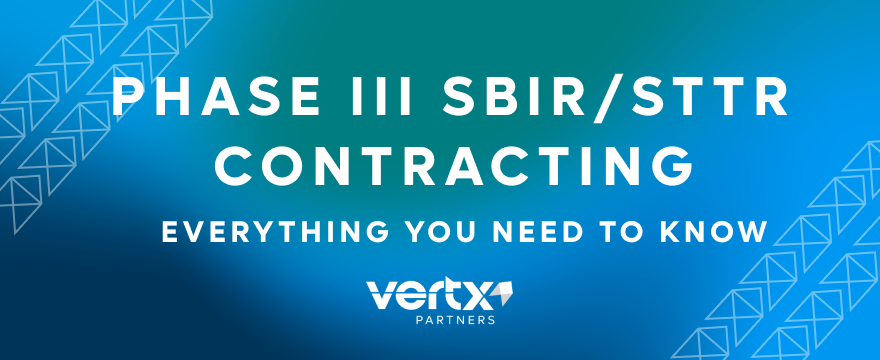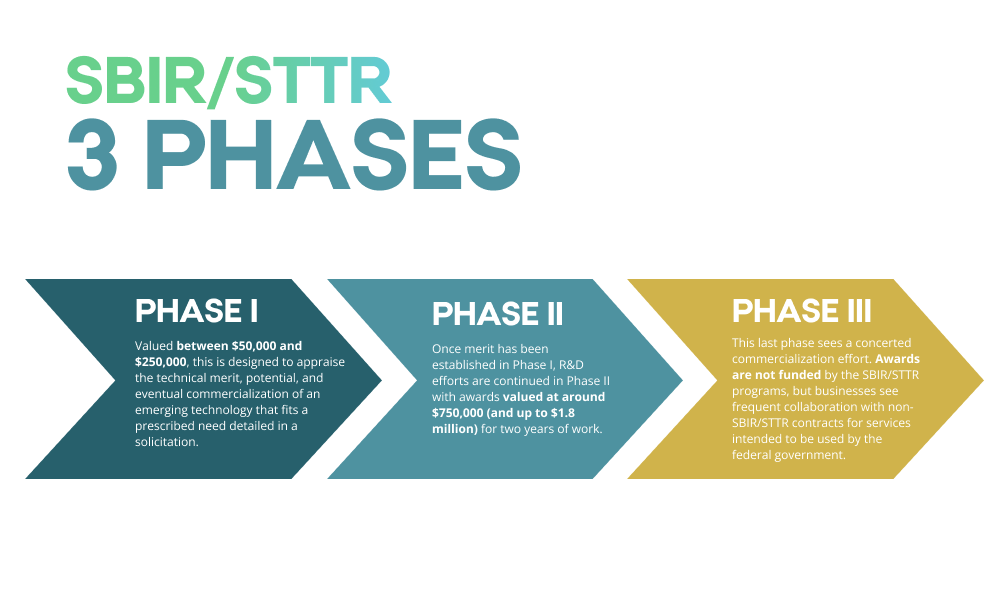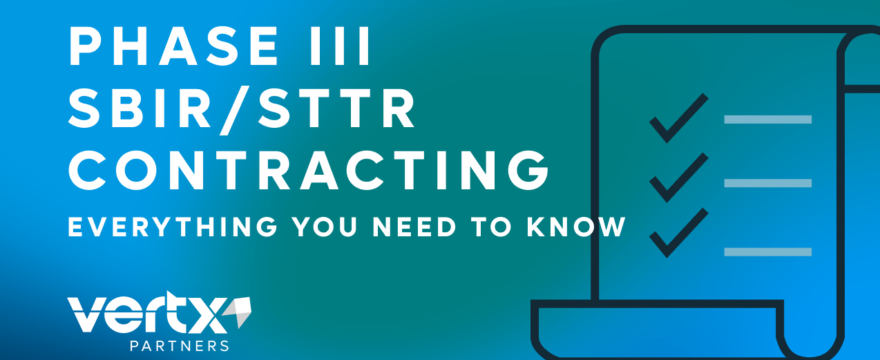For many businesses, securing a Phase III SBIR/STTR is a game-changer for success. In this article, we’ll explain the intricacies of the Phase III process and how you can master it.

Earlier, we drafted an extensive Small Business Innovation Research (SBIR) / Small Business Technology Transfer (STTR) guide to help prospective government contractors get started with a Phase I SBIR/STTR. Additionally, for a deeper dive, you can peruse the Small Business Administration’s (SBA) 157-page overview of the SBIR/STTR programs.
For a quick refresher, the SBIR and STTR programs aim to promote federal R&D (Research and Development) needs through small business innovation. The eventual goal of this process is commercialization.

The federal government splits both programs into three Phases:
- Phase I (Concept Development): Valued between $50,000 and $295,000, the first Phase of the program is designed to appraise the technical merit, potential, and eventual commercialization of an emerging technology that fits a prescribed need detailed in a solicitation.
- Phase II (Prototyping): Once merit is established in Phase I, R&D efforts continue in Phase II with awards valued at around $750,000 (up to $1.97 million) for two years of work.
- Phase III (Commercialization): This last Phase sees a concerted commercialization effort that applies to federal government markets. Federal agencies award sole-source contracts with non-SBIR/STTR funds. The work must derive from, extend, or complete these Phase I and II technologies.
You’ll notice how the government guides the first two Phases. Private businesses respond to federal solicitations, are funded by federal SBIR/STTR dollars, and develop technology evaluated by federal means.
Phase III shakes the mold.
How Phase III Differs
Technologies born out of proof of concept in Phase I and/or further developed in Phase II are high-risk, high-impact. While they have the potential to become marketable, these technologies don’t always transfer. Likewise, it is not necessary to complete Phase I and Phase II to move into the Phase III process. In fact, Phase III can be entered directly from an incomplete Phase I contract.
Phase III departs from the federally guided philosophy of the first two Phases by putting the ball back in the business’s court. At this point in the program, the company is responsible for selling its technology.
With business-led commercialization, the unscripted nature of Phase III allows businesses to try taking their product to the private market or selling it in the multibillion-dollar federal contracting marketplace. Either option can prove highly lucrative for firms with a successful product — developed with government funding, no less.
Although the government ceases SBIR/STTR award funding in this Phase, additional federal funding options are easily available should a business decide to pursue that route.
Digging Deeper into Phase III
SBIR/STTR policy directives define commercialization as the following process:
“The process of developing products, processes, technologies, or services and the production and delivery (whether by the originating company or others) of the products, processes, technologies, or services for sale to or use by the Federal government or commercial markets.”
It’s a simple enough process that all businesses engage in when they develop a product to sell to the market. But should your business continue down the federal route, can an agency fund your technology with non-SBIR/STTR dollars?
The quick answer is yes, sometimes. Functionally, this is the equivalent of a “Phase III SBIR/STTR award,” although you’ll source the funding from elsewhere.
But why should a business expect additional federal funding after departing from the program?
Attributes of Phase III
Numerous aspects of the Phase III contract are mutually beneficial to the participating business and agency.
For example, Phase III awards are sole-source. With competition requirements met in the prior two Phases, awards may now be allocated on a non-competitive basis to a Prime contractor because their work derives from, extends, or completes work performed under a prior SBIR/STTR agreement.
Additionally, there is no limit on the number, award amount, or duration of Phase III awards. Any agency can make these awards, regardless of their participation in Phases I and II of the SBIR/STTR programs. If you continue to engage with the agency you’ve engaged with in Phases I and II, they are within their rights to engage in a Phase III award at any point during the Phase I and II process with you. And if your business grows by the time you’re in Phase III, small business size standards no longer apply to you.
As you can see, the unscripted nature of Phase III awards allows leeway for both the contractor and the client. Several additional benefits include:
- A broad scope of awards covering products, production, services, and research.
- Services and materials can be acquired through the same Phase III contract.
- Any teammates are fair game, from small and large businesses to universities and Federally Funded Research & Development Consultants (FFRDCs).
- All types of federal funding can be used (except for SBIR/STTR funding).
- Any federal agency can issue a Phase III award.
- Any security level can be supported.
- There is no time limit on the elapsing between a Phase I/II award and a Phase III award or between separate Phase III awards.
- Any contracting options are available, including cost plus, time and materials, and firm fixed price.
Wrapping Up
A Phase III award is the ultimate goal for most businesses engaging in the SBIR/STTR process. Phase III acquisition starts in Phase I, however, which can prove challenging to navigate as you work out a proof of concept and test the viability of technologies. And that’s not to mention several of the logistical challenges of this work. In fact, if your company is still at the “starting line” of this process, you might find several of the following external resources on how to get started helpful:
- The Small Business Technology Council (SBTC) website contains a treasure trove of DoD SBIR/STTR Phase III resources.
- SBIR.gov offers a free overall SBIR/STTR tutorial.
Do you think a Phase III SBIR/STTR award is in your future? Want to step off on the right foot in federal contracting? Reach out to Vertx Partners today – our staff has decades of experience with the SBIR/STTR programs. It only takes a few minutes to complete our survey to receive a personalized response that will set you on the right path.
